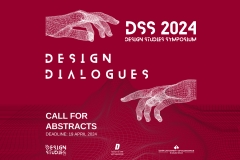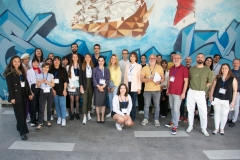
GRADUATE SCHOOL
Ph.D. In Design Studies
FFD 602 | Course Introduction and Application Information
| Course Name |
Integrated Approaches in Design
|
|
Code
|
Semester
|
Theory
(hour/week) |
Application/Lab
(hour/week) |
Local Credits
|
ECTS
|
|
FFD 602
|
Spring
|
3
|
0
|
3
|
7.5
|
| Prerequisites |
None
|
|||||
| Course Language |
English
|
|||||
| Course Type |
Required
|
|||||
| Course Level |
Third Cycle
|
|||||
| Mode of Delivery | - | |||||
| Teaching Methods and Techniques of the Course | Discussion | |||||
| Course Coordinator | ||||||
| Course Lecturer(s) | ||||||
| Assistant(s) | - | |||||
| Course Objectives | The aim of the course is to ensure that PhD students with various design and/or disciplinary backgrounds develop a common and integrated design understanding through philosophy, culture, history, theory and contemporary discourse, and also by considering the interactions between arts and science fields. |
| Learning Outcomes |
The students who succeeded in this course;
|
| Course Description | This course is a research-based course that can be studied either on a theoretical route and/or theory-practice route. In the context of the course, the concepts related to the different areas of design will be discussed through an integrated approach by the theoretical framework and the developments from a historical perspective. Together with the development of the skills and understanding of a multi facet design approach, students are expected to develop an understanding and discuss the importance of inter/multidisciplinary teamwork and have a common knowledge and language for the formation of these design teams as the main objectives of the course. |
|
|
Core Courses |
X
|
| Major Area Courses | ||
| Supportive Courses | ||
| Media and Management Skills Courses | ||
| Transferable Skill Courses |
WEEKLY SUBJECTS AND RELATED PREPARATION STUDIES
| Week | Subjects | Related Preparation |
| 1 | Introduction to the Course, Design History, Description of the weekly assignments --- Design Thinking: What is Design? Designerly Ways of Thinking --- Design Process | Reading: 1) Cross, N. (2001) “Designerly ways of knowing: Design discipline versus design science” Design Issues, Vol 17 No 3, 49-55. 2) Razzouk, R. & Shute V. (2012) “What is Design Thinking and Why is It Important?” Review of Educational Research, Vol 82No 3, pp. 330-348. |
| 2 | Design & Research Methods | Reading: 1) Creswell, J. W. “Choosing a Mixed Methods Design |
| 3 | Design Research | Reading: 1) Cross, N. (1999) “Design Research: A Disciplined Conversation” Design Issues, Vol. 15 No 2, pp. 5-10. |
| 4 | Design, Aesthetics, and Ethics | Reading: 1) Fry, T. (2006) “Design, Ethics and Identity” Design Philosophy Papers, Vol 4 Iss 3, pp. 161-166. 2) Danto, A. C. (2009) “Aesthetics and the Work of Art” Design Studies: A Reader. Ed. Clark, H and Brody D., New York: Berg, pp.150-153. 3) Devon, R. & Van De Poel, I. (2004) “Design Ethics: The Social Ethics” Int. J. Engng Ed. Vol 20 No 3, pp. 461-469. |
| 5 | Design and Science | Reading: 1) Norman, D. A. (2007) “The Future of Everyday Things” The Design of Future Things. 155- 176. 2) Moles, A. (2009) “Design and Immateriality” Design Studies: A Reader. Ed. Clark, H and Brody D., New York: Berg, pp.377-383. |
| 6 | Equality, Social Justice, Participatory Design | Reading: 1) Kvan, Thomas (2000) “Collaborative Design: What is it?” Automation in Construction 9, pp. 409-415. 2) TBA Term Project Final Review |
| 7 | Innovation, Sustainability, Designing for a Safe Future | Reading: 1) Papanek, V. (2009) “Designing for a Safe Future” Design Studies: A Reader. Ed. Clark, H and Brody D., New York: Berg, pp.469-473. 2) Wylant, B. (2008) “Design Thinking and the Experience of Innovation” Design Issues, Vol 24 No 2, pp. 3-14. |
| 8 | Take-Home Midterm Exam | Submission (Date: TBA) |
| 9 | Interaction Design | Reading: 1) Kolko, J. (2010) “Chapter 6: Interaction Design and Communication” Thoughts on Integration Design. Canada: Elsevier, pp. 105-118. 2) Fallman, D. (2008) “The Interaction Design Research Triangle of Design Practice, design Studies, and Design Exploration” Design Issues. Vol 24 No 3, pp. 4-18. |
| 10 | User-Centered Design | Reading: Norman, D. A. (1988) The Design of Everyday Things. USA: Basic Book |
| 11 | Deneyimsel Tasarım | Reading: 1) Sanders, E. B.-N. (2002) “Scaffolds for Experiencing in the New Design Space” Information Design, Institute for Information Design Japan, IID.J, Graphic-Sha Publishing Co., Ltd 2) TBA |
| 12 | Student presentations | |
| 13 | Student presentations | |
| 14 | Review of semester | |
| 15 | Final Submission: Final text submission and presentations through BB collaborate. | Final Submission Requirements |
| 16 | Review of the Semester |
| Course Notes/Textbooks |
|
| Suggested Readings/Materials |
|
EVALUATION SYSTEM
| Semester Activities | Number | Weigthing |
| Participation | ||
| Laboratory / Application | ||
| Field Work | ||
| Quizzes / Studio Critiques | ||
| Portfolio | ||
| Homework / Assignments | ||
| Presentation / Jury | ||
| Project |
1
|
100
|
| Seminar / Workshop | ||
| Oral Exams | ||
| Midterm | ||
| Final Exam | ||
| Total |
| Weighting of Semester Activities on the Final Grade |
1
|
100
|
| Weighting of End-of-Semester Activities on the Final Grade | ||
| Total |
ECTS / WORKLOAD TABLE
| Semester Activities | Number | Duration (Hours) | Workload |
|---|---|---|---|
| Theoretical Course Hours (Including exam week: 16 x total hours) |
16
|
3
|
48
|
| Laboratory / Application Hours (Including exam week: '.16.' x total hours) |
16
|
0
|
|
| Study Hours Out of Class |
0
|
||
| Field Work |
0
|
||
| Quizzes / Studio Critiques |
0
|
||
| Portfolio |
0
|
||
| Homework / Assignments |
0
|
||
| Presentation / Jury |
0
|
||
| Project |
1
|
177
|
177
|
| Seminar / Workshop |
0
|
||
| Oral Exam |
0
|
||
| Midterms |
0
|
||
| Final Exam |
0
|
||
| Total |
225
|
COURSE LEARNING OUTCOMES AND PROGRAM QUALIFICATIONS RELATIONSHIP
|
#
|
Program Competencies/Outcomes |
* Contribution Level
|
||||
|
1
|
2
|
3
|
4
|
5
|
||
| 1 | to be able to develop scientific expertise and capabilities in the field of design studies by using creative and critical thinking as well as research skills; innovatively contributing to the discipline through new ideas, |
X | ||||
| 2 | to be able to comprehend the interaction across various disciplines related to the field of design reaching at original conclusions via using new and complex analysis, synthesis and evaluation skills, |
X | ||||
| 3 | to be able to develop new strategic approaches to solve unforeseen complex issues in design practice through integrative and creative elaboration, |
|||||
| 4 | to be able to conduct independent research, analyze scientific phenomena through a broad, deep and critical perspective, arrive at new syntheses and evaluations in design discipline, |
X | ||||
| 5 | to be able to publish scientific articles in reputable refereed journals, present papers in scientific conferences in the field of design and its sub-disciplines, |
|||||
| 6 | to be able to develop effective communication skills to scientifically present and defend original ideas to an expert audience, |
|||||
| 7 | to be able to conduct affective team work in the field of design, |
|||||
| 8 | to be able to use the English language fluently for both comprehending scientific publications and developing proper communication with foreign colleagues, |
X | ||||
| 9 | to be able to contribute to the process of transforming into an " information society", by following the technological, social and cultural developments on both academic and professional grounds continuously, |
X | ||||
| 10 | to be able to develop skills of designing and producing unique models and products that will be certificated as registered design, trade mark and patents. |
|||||
*1 Lowest, 2 Low, 3 Average, 4 High, 5 Highest
NEWS |ALL NEWS

DSS 2024 CALL FOR PAPERS | THEME: DESIGN DIALOGUES
DSS 2024 CALL FOR PAPERS THEME: DESIGN DIALOGUES The Design Studies Graduate Program and the Faculty of Fine Arts and Design at the Izmir

Design Studies Symposium 2023: Realities & Frontiers
The Design Studies Symposium 2023 (DSS 2023) organized by the IEU Graduate School Design Studies programs was held on 1-2 June, at




